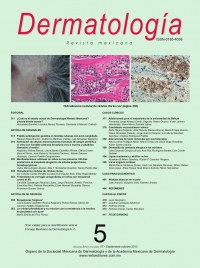Resumen
Antecedentes: la pared celular de Candida albicans está compuesta principalmente por los polisacáridos manán, glucán y quitina. El polisacárido manán representa alrededor de 15.2 a 22.9% del peso seco y poco más de 40% de los polisacáridos de la pared celular del hongo. El D-glucán b-1-3 y el b-1-6 constituyen entre 47 y 60% del peso seco de la pared celular. Se han reportado otros componentes, como proteínas en cantidades entre 6 y 25%, lípidos entre 1 y 7%, y quitina entre 0.6 y 9% del peso de la pared celular. Especies de Candida opsonizada son ingeridas por los monocitos y macrófagos, pero organismos de Candida no opsonizada son fagocitados sólo por estos últimos, principalmente a través del enlace para el receptor de manosa. El interferón gamma (IFN-g), normalmente producido por linfocitos T activados, es uno de los principales factores que aumentan las actividades fagocíticas y la destrucción de Candida albicans en macrófagos humanos. Objetivo: demostrar que ocurre estimulación de células mononucleares humanas in vitro con Candida albicans viva, muerta, o con péptidos liberados al medio, mediante cuantificación de la secreción de la IL-2 y el IFN-γ. Material y método: el crecimiento de Candida albicans (ATCC 10231) se efectuó en el medio de Sauton durante cinco días, a 37ºC, se centrifugó y se separó la biomasa del medio, se ajustó al tubo 2 del nefelómetro de McFarland 600 x 106 UFC/mL en solución salina. Se dividió en cuatro fracciones, dos para utilizarlas como Candida albicans viva y dos como Candida albicans muerta (se trató con calor húmedo a 121ºC, a 15 libras de presión, durante 15 minutos). Asimismo, se tomó una fracción de cada una (cepa viva y cepa muerta) para someterlas a opsonización con suero humano normal, incubándolas a 37ºC durante una hora. Al sobrenadante se le precipitaron las proteínas con solución saturada de sulfato de amonio, se le llevó hasta 50% de saturación, se centrifugó y se resuspendió el precipitado en 3 mL de agua; se dializó contra agua, se determinó la concentración de proteínas por el método de Lowry y se ajustó el antígeno a una concentración de 1 mg/mL. Las células mononucleares humanas se purificaron con el método de Boyum y se ajustaron a una concentración de 2 x 106 cel/mL. Resultados: con el objetivo de estimular células mononucleares humanas in vitro, el uso de levaduras de Candida albicans muertas por calor da buenos resultados en la inducción de IFN-g y de IL- 2, pero los mejores resultados se obtuvieron al estimular a estas células con péptidos provenientes del microorganismo. Conclusión: es preferible estimular al sistema inmunológico para la inducción del IFN-g con péptidos obtenidos de estos microorganismos, o con Candida albicans muerta por calor húmedo. Palabras clave: Candida albicans, estimulación de IFN-g, estimulación de IL-2.
Palabras clave: Candida albicans, estimulación de IFN-g, estimulación de IL-2
Abstract
Abstract Background: The cell wall of C. albicans is mainly composed of polysaccharides manan, glucan and chitin. Manan polysaccharide represents approximately 15.2% to 22.9% of dry weight and slightly more than 40% of the cell wall of fungus polysaccharides. The D- glucan 1-3 and the D-glucan 1-6- are between 47% and 60% of the dry weight of the cell wall. Other components have been reported, such as protein in quantities ranging between 6% and 25%, lipids between 1% and 7% and chitin between 0.6% and 9% of the weight of the cell wall. Species of Candida opsonizaded are ingested by monocytes and macrophages, but Candida organisms not opsonizaded are phagocytosed only by the latter, mainly through binding to mannose receptor. IFN-g, normally produced by activated T lymphocytes, is one of the main factors that increase activity phagocytic and destruction of C. albicans in human macrophages. Objective: To demonstrate that it occurs stimulation of human mononuclear cells in vitro with Candida albicans alive, dead, or peptides released into the environment, quantifying the IFN-γ and IL-2 secretion. Material and method: The growth of Candida albicans (ATCC 10231) was carried out in the middle of Sauton, for 5 days at 370ºC, centrifugation and broke the biomass of the medium, adjusted to tube the McFarland Nephelometer 600 2 x 106 CFU/mL saline. Divided into 4 fractions, 2 for use as C. albicans live and 2 as C. albicans dead (was treated with moist heat to 249.8ºF (121ºC) at 15 lbs of pressure for 15 minutes). It takes a fraction of each (strain alive and dead strain) for consideration by opsonization with normal human serum, incubating at 37ºC for 1 h. To the supernatant proteins is precipitated with ammonium sulphate saturated solution, bringing it up to 50% saturation, centrifuged and the precipitate was resuspended in 3 mL of water, dialyzed against water, protein concentration was determined by the Lowry method and adjusted antigen at a concentration of 1 mg/mL. Human mononuclear cells are purified by the method of Boyum and adjusted at a concentration of 2 x 106 cel/mL. Results: With the purpose of stimulating human mononuclear cells in vitro, the use of yeast Candida albicans core heat gives good results in both IL-2 as IFN-g obtained to stimulate these cells with peptides from the microorganism. Conclusion: It is preferable to stimulate the immune system for induction of the presence of IFN-g with peptides obtained from the microorganism, or Candida albicans dead heat damp. Key words: Candida albicans, stimulation of IFN-g, stimulation of IL-2.
Keywords: Candida albicans, stimulation of IFN-g, stimulation of IL-2

